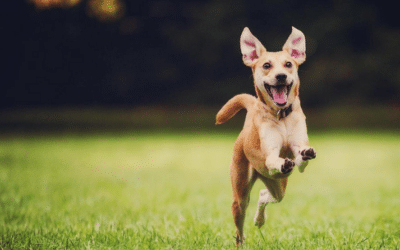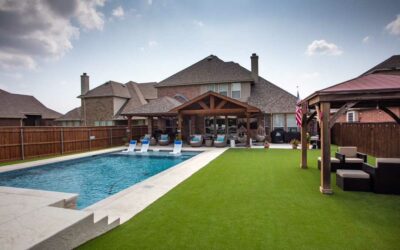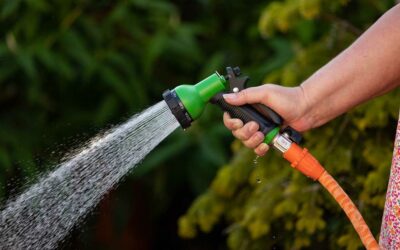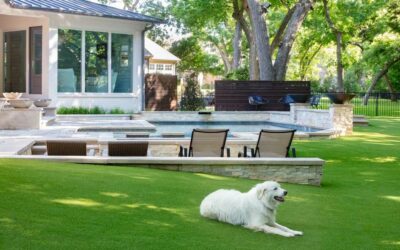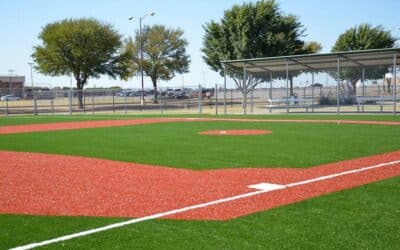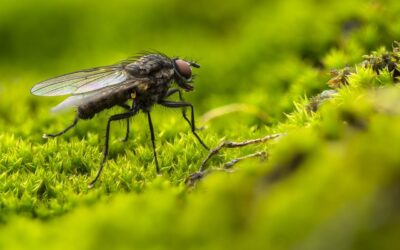What Are The Pros & Cons of Artificial Grass For Dogs
For many years, people have been debating whether artificial grass is appropriate for dogs. Some people argue that it’s the best thing you can do for your furry friend, while others insist that it’s the worst thing you could possibly do.
Does artificial grass work for dogs? Let’s find out as we break down some pros and cons of artificial grass for dogs.
Pros of artificial grass with dogs
Say goodbye to mud
The primary advantage of artificial grass is that it doesn’t get muddy, even during rainy days. Dogs love to run around and play outside, but they also love to bring their muddy paws into the house. With artificial grass, you can let your dog run around without worrying about mud getting all over your floors.
No more holes in the backyard
Dogs dig and make holes in the yard, which means more work for you. With artificial grass, you won’t have to worry about any of that. You can let your dog run around and play without having to worry about the lawn being ruined.
Fewer baths for your dog
You can let them run around on the grass and not worry about how much mud and dirt they’re going to bring into your house. No more frequent bath times, and you’d have more time for more important matters.
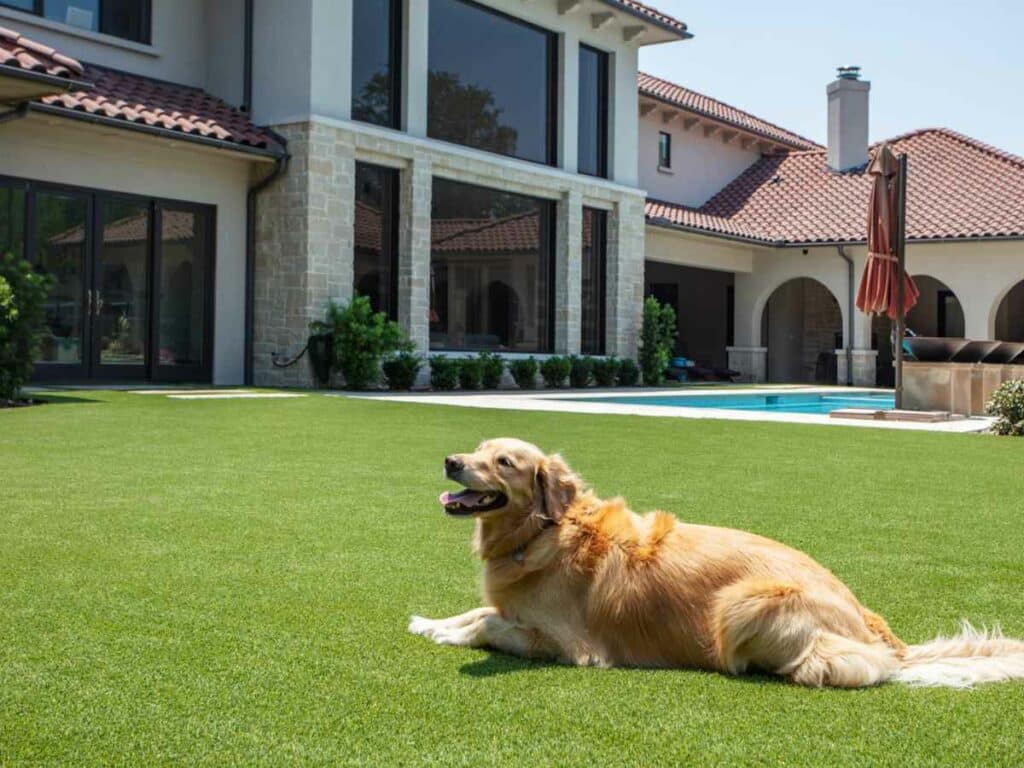
No yellow stains
Natural grass tends to become yellow when splashed with dog urine. The bad news is it’s rather hard to make it green again. On the contrary, artificial grass stays green even with contaminants such as dog urine.
No grass trimmings inside the house
With no grass clippings sticking into your dog’s paws, your home is much easier to maintain. Additionally, you may not need to use a vacuum cleaner as your surroundings will remain clean for extended periods of time.
Less bugs and fleas
This is one of the best answers to the question, “Is turf good for dogs?” Bugs don’t like synthetic grass as much as natural grass and mud, which means pests will less likely inhabit the fur of your pets that spend time on the artificial turf. This also means no grass getting inside your home, no matter how many times your dog rolls around and plays.
See: How to Get Rid Of Flies On Artificial Grass
Less smells
Unlike natural grass, artificial grass does not have organic matter, such as soil and roots, that can decompose and create an unpleasant smell. In contrast, natural grass can accumulate organic matter, such as dead leaves, animal waste, and other debris, which can lead to the growth of bacteria and other microorganisms.
These microorganisms can produce odors that are often associated with natural grass. By using artificial grass instead of natural grass, there is less organic matter for bacteria and other microorganisms to grow on, which can result in less odor.
Tough and durable
One of the main advantages of artificial grass is its toughness and durability. When properly installed, artificial grass can last for years without requiring major repairs or replacements. Unlike natural grass, which can be easily damaged by extreme weather conditions, artificial grass can withstand a wide range of weather conditions.
Can dogs tear up turf? Yes, but since artificial turf is designed to be highly resistant to wear and tear, it would be able to withstand the impact much better than natural turf.
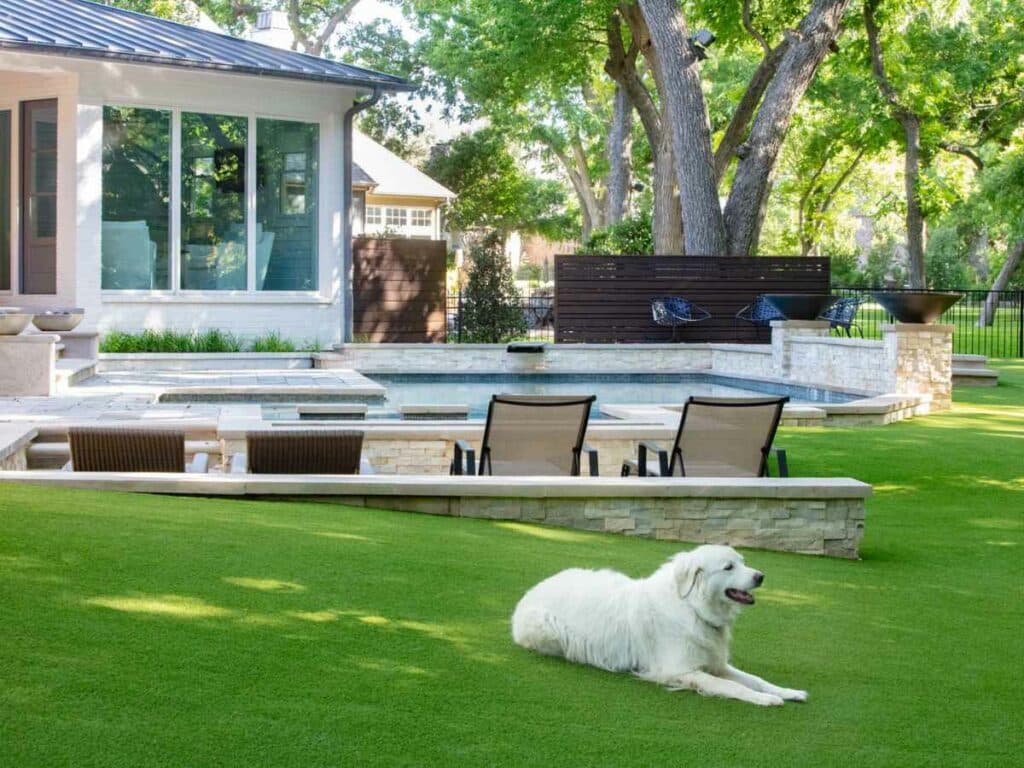
Cons of fake grass for dogs
Higher upfront cost of installation
Installing synthetic grass is more expensive than real grass initially, with an average cost between $8-12 per square foot compared to $1-2 per square foot for sod installation. The installation of natural grass may require a sod cutter and a roto-tiller, while artificial grass requires additional tools such as infill, edging, adhesives, and synthetic grass itself.
Despite the higher upfront investment for artificial turf, it can be more cost-effective in the long run due to the lower maintenance costs compared to natural grass. At the end of the day, the decision to install artificial or natural grass should be based on the consideration of the initial cost versus the maintenance cost in the future.
Low-quality turfs are sometimes made with toxic chemicals
Is artificial grass ok for dogs? Not entirely. Some low-quality artificial turfs are most likely made with substandard materials and manufacturing processes. Toxic chemicals such as lead, cadmium, and phthalates can be used in production, and these can be harmful to dogs, humans, and the environment. To avoid potential hazards, it is essential to use pet-approved and safe pet turf products that do not contain harmful chemicals.
If you are looking for pet safe turf options check out our artificial turf for pets.
Cleaning dog poop may require a hose down
When a dog defecates on artificial grass, the feces cannot decompose in the same way as on natural grass, making cleaning more difficult and potentially leading to unpleasant odors, unsanitary conditions, and damage to the artificial grass. Cleaning may require the use of a hose or other cleaning equipment to remove the feces completely.
Heats up with sunlight
Artificial grass is made of plastic materials that can absorb and retain heat, which causes it to become hotter than natural grass when exposed to sunlight. Manufacturers have developed cooling technology to reduce the heating effect, but all types of artificial grass will still heat up to some extent when exposed to direct sunlight.
Doesn’t drain like real grass
Real grass has a natural drainage system that allows water to seep through the soil and into the ground below, while artificial grass does not have the same drainage capabilities. This can lead to water accumulating on the surface, especially during heavy rains or when the grass is installed over a poorly-draining sub-base.
To avoid this, it is important to make sure that the installation is done correctly using a suitable base and adequate drainage measures. Picking a high-quality product that is right for the intended use and location can also help improve the turf’s drainage capabilities.
Artificial grass has both pros and cons to consider if you are a dog owner. However, it can provide a low-maintenance and safe environment for dogs to play. It is also very durable and can withstand heavy foot traffic and weather conditions.
Note it may also require routine pet waste cleaning and maintenance to prevent odor buildup. Ultimately, the decision to use artificial grass for dogs depends on the user’s circumstances and preferences.
Looking For Artificial Turf in Texas?
Our team at Artificial Grass Pros provides premium quality artificial grass that is completely safe for your pets. Contact us today for your free estimate or check out our pet turf options.

